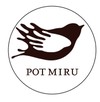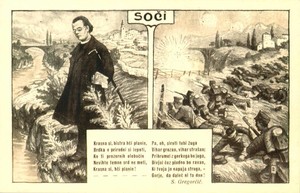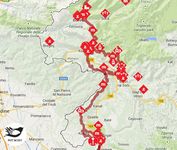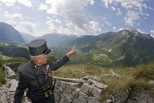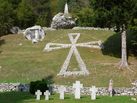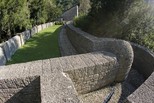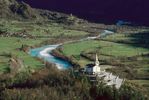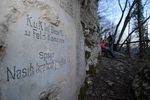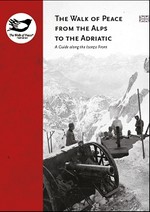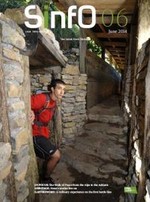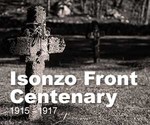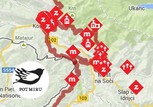Walk of Peace from the Alps to the Adriatic
Indelible memories of the First World War can be found in every corner of the Upper Soča Valley, the Nova Gorica area, the adjacent Brda Hills, the Vipava Valley and the Kras. Every cave, fortification, trench, church, path, mule track, hill, mountain, ossuary, cemetery and museum has its own story to tell to those who know how to listen and see, understand and respect.
The Walk of Peace from the Alps to the Adriatic links areas, institutions and the rich cultural and natural heritage along the Isonzo Front (1915–1917) from Mt Rombon to Duino. The Isonzo Front witnessed one of the largest mountain battles in the history; the eleventh and twelfth Soča battles were the largest ever fought on Slovenian territory.
The trail along the historic heritage of European significance is a memorial to those who suffered in the First World War and a reminder of why wars should not be fought. It promotes the value of peace and opportunities for joint development – for cooperation and reconciliation of the nations once engaged in the warfare.
The Walk of Peace has offered an opportunity to increase the visibility of the cross-border region and develop its tourism and services; to remember the historic turmoil witnessed by these secluded places they networked to a cross-border T-lab and gave the word to the Emerald River: Soča, do tell.
"Bitter steel will strike upon these lands, and you will flow full of blood"
Today, the remnants bearing testimonies and conveying feelings and stories recall the horrors of the Isonzo Front, foreseen already in 1879 in the words of Simon Gregorčič, a Slovenian poet, in his poem To the River Soča ("Bitter steel will strike upon these lands, and you will flow full of blood: our blood will nourish you, the enemy's will muddy you!"). They are the backbone of the Walk of Peace along the Soča River from the Julian Alps to the Adriatic.
The Walk of Peace from the Alps to the Adriatic will be opened by the Presidents of Slovenia and Italy in March 2015 with a ceremony on a square shared by Nova Gorica and Gorizia; the Walk of Peace will link the Walk of Peace in the Upper Soča Valley, the Globočak hill, Mt Korada, the Sabotin Peace Park, the Kras Walks of Peace and numerous outdoor museums and trails from Mt Rombon to Duino which were constructed in 2014 as parts of the Walk of Peace/Via di pace project.
A few outstanding WWI sites along the Walk of Peace:
Cross-border Area
The Walk of Peace from the Alps to the Adriatic winds along the Soča River to connect the Isonzo Front heritage with the beauties of the alpine, subalpine and karst worlds and reveal its alpine pastures (which are still in use), cultural monuments, museums and private collections; the tourist information centres assist visitors, and tourist service providers offer them places to rest, a taste of home-made food or just a chat with local people. The peace and quiet and the views over this unique cross-border area can be enjoyed along the Walk. It is suitable for hikers and bikers; some places are also accessible by vehicles. Experienced local tourist guides are on hand to tell numerous stories related to history and life today.
Route
The Walk of Peace from the Alps to the Adriatic starts at Log pod Mangartom village, descends to the Kluže Fortress, passes Mt Ravelnik and Čelo Hill Outdoor Museum to climb to the Golobar pasture and the Zaprikraj Outdoor Museum; it then descends from Drežnica, passes the Italian Ossuary and reaches Kobarid, where it divides into two paths. One route climbs to the Kolovrat Range and its outdoor museum, while the other runs across the Kuhinja and Pretovč pastures to reach the Mt Mrzli vrh Outdoor Museum, where it starts to descend to the Church of the Holy Spirit at Javorca and further down to Tolmin, the German Ossuary and the Mengore Hill Outdoor Museum, where this section of the Walk ends. From the Kolovrat Range Outdoor Museum, the route passes Globočak Hill and the Kambreško area to reach Mt Sabotin and the Brda Hills; the other route descends from the Kolovrat ridge to Plave village and climbs the Prižnica–Vodice–Sveta Gora ridge and Škabrijel Hill. The routes meet in Nova Gorica/Gorizia. The Walk continues across the top of the Markov hrib slope and the hills of Vrtojbensko-biljenski griči to the Cerje Memorial and the Kras Walks of Peace. Here, the Walk of Peace again forks into two paths that cross the former border. The first links the Brestovec Historical Trail/Percorso storico del Brestovec, Debela Griža/Monte San Michele, the Italian Ossuary in Sredipolje/Redipuglia, the Theme Park/Parco Tematico Grande Guerra above Tržič/Monfalcone and ends in Devin/Duino. The second path winds through the Kras to connect the throne of Borojević, Krompir Cave, Gorjansko and some Austro-Hungarian cemeteries, crosses Grmada/Ermada and descends to Devin/Duino.
Kobarid Museum, Tolmin Museum, Goriška Museum, the Provincial Museums of Gorizia/Musei Provinciali di Gorizia and numerous private collections complement the Walk of Peace and bear testimony to the region's past. The Walk is a place where science, diary memoires, research, the findings of the Research Centre of the Slovenian Academy of Sciences and Arts ZRC SAZU, personal experience and the memories of visitors and local residents meet.
In cooperation with municipalities, local associations and tourism organisations
The Walk of Peace from the Alps to the Adriatic has been created in cooperation between the municipalities of Bovec, Kobarid, Tolmin, Kanal, Brda, Nova Gorica, Šempeter Vrtojba, Miren Kostanjevica, Komen and the associations, local tourism organisations and tourist information centres of the Emerald Route destination. Its partners in Italy are the Provinces of Trst/Trieste and Videm/Udine and Gorica/Gorizia, which leads the cross-border the Walk of Peace/Via di pace project, some Italian municipalities and mountain communities. A number of other municipalities and organisations participate in individual activities. The Institute for the Protection of Cultural Heritage of Slovenia, Nova Gorica Regional Office, plays an important role in preserving this heritage. The Tourism Division of the SPIRIT Slovenia, Public Agency, and the Friuli–Venezia Giulia Tourism Agency are important partners handling tourism.

